When going on holiday, you probably start packing a few days before the actual trip. Some women even start packing a week before.
With my life (hotel in-hotel out) packing is just a matter of a few minutes, because I never unpack haha. But when I leave from home it's best not too forget anything.
You will find a check-list on this site, so you won't forget anything!
Documents
Flight-ticket, reservation proof in case of E-ticket
Passport with Visum if needed, Id-card
Hotel reservation or other vouchers for any reservations
Clothes
(Depends on the place and weather of course)
Undies, socks
T-shirts, shirt, trousers
Sweater
Raincoat, Jacket
Shoes, slippers
Swimming gear
Evening clothes
Toilet-requisites
Toothbrush+paste
Shampoo
Deodorant, perfume
Nailclippers
Cotton buds
Shaving blade+foam
Women stuff: nail polisher, lipstick, sanitary napkins, ...
Medicine (against diarrhoea, headache, mosquito's, antibiotics, ...)
Glasses, lenses,
Sunburn lotion
Entertainment
Books (guide books, dictionaries or just plain reading books), maps, GPS
Telephone+charger
Camera+charger
Universal electricity plug
Cd's
Others
Money, Payment cards
Swiss knife
Pen and paper
Presents
Ear plugs
Sunglasses
Yeah maybe I forgot things here, but remember in most countries, you can also buy those things . And when you travel with an empty suitcase, you can carry more present home and your relatives will love you!
Remember the international rules for hand luggage! You might loose your expensive perfume if you forget to put it in your check-in luggage.
Friday, August 31, 2007
Check-list
Posted by MiGlainne at 4:42 AM 0 comments
Labels: Before travelling
Wednesday, August 29, 2007
Yellow
Ah Yellow it's a nice song by Coldplay and also my favourite colour. But it's also a colour you will encounter a lot on your trips in Asia. It's the colour of some prayer flags in Tibet, the colour of some beautiful orchids, ...
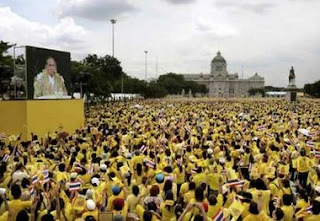 ngest living monarch in the world and his birthday will be celebrated by all the Thai people.
ngest living monarch in the world and his birthday will be celebrated by all the Thai people. King Bhumibol was born on a Monday and the yellow colour is his birthday colour. That's why his flag with his emblem inside is yellow and the T-shirts to honour him have the same colour.
On special occasions connected with the Queen, the streets will be covered with blue flags and people will wear blue T-shirts, because the Queen was born on Friday.
Some old palaces, built by Rama 5, are decorated with pink paint, because Rama 5 was born on a Tuesday.
Thai people will not change a T-shirt every day according to the colour, neither will they always wear the same colour because they are born on a special day. It is the yellow T-shirt for the King that is omnipresent and not only on Mondays. More striking in Bangkok and big cities than small villages, but even there in hilltribe villages people wear those yellow T-shirts sometimes (if they are not too dirty).
I also like to walk around with a yellow T-shirt, not really to honour the King, but because it is my favourite colour (yes I am also born on a Monday) and because it's easy for people to spot me in the crowd. That is for my job of course. In a group of foreigners I would be recognizable with such a T-shirt, but not in a group of Thai people, luckily I am taller than most Thai :-).
When I walk around in a yellow T-shirt in China this has not really a meaning, but it used to be a forbidden colour. Yellow was only for the emperor. His clothes and seats would be made by yellow silk. Even his roofs were painted in yellow. So now when I walk around with a group in the forbidden city in Beijing and I wear my yellow T-shirt to be easily spotted, there is no problem. But 400 years ago I would have lost my head!
You will see on the picture the Buddha from left to right. The first one for Sunday going all the way to Saturday.
Sunday - Reflecting Buddha
Standing and 2 hands crossed on the upper thigh.
After his enlightenment Buddha stays in meditation for 7 days and gets the knowledge about all his previous lives and everybody' lives. He gets the 'Matrix' insight.
Monday -Buddha stopping the conflict
Standing and right hand (or two hands) raised.
Buddha returned from heaven and some relatives were fighting over the rights of water for irrigating their fields. Buddha stopped the fight.
Tuesday - Reclining Buddha
Lying down and his feet on same height (if not is just a sleeping Buddha)
Buddha dies and enters the Nirvana.
Wednesday(daytime) - Buddha with bowl
Standing Buddha is holding the bowl for his alms at the waist. Nowadays monks still have the bowl as one of their only possessions.
Thursday - Meditating Buddha
Sitting and with both hands on his lap.
Before he gets the enlightenment.
Friday - Contemplating Buddha
Standing and both hands crossed at the chest.
Buddha is thinking if and how he has to bring his teachings to the humans.
Saturday - Buddha under Naga snake
Buddha is sitting in meditation on the body of the snake and the heads protect him.
In mythology first a bad creature, the Naga will come to help the Lord Buddha during his meditation. He protects the Buddha for a heavy rainstorm.
Wednesday(nighttime) -Buddha receiving gifts from monkey and elephant
Sitting and opening up his right hand and closing his left hand.
Because in Thai tradition Wednesday evening is connected with full moon, there is a special Buddha for people born on Wednesday evening.
Buddha is resting and animals come to pay respect to him. The elephant offers him a pot of water and Buddha accept his gift. The monkey offers him a bamboo tube filled with honey, but the Buddha refuses the gift (closed hand) because there might be living creatures (bees) inside.
If you look closely at the picture, yeah totally at the end, you will see there is another statue. That is the one in the position called "Buddha subduing the god Mara". Just before he got to the stage of enlightenment the bad god Mara came to disturb his meditation. The lord Buddha gets his right hand out of his lap and points to the ground. Because of all his merit (the good things he did, his good karma) the goddess of earth came to help him and washed away all the evil and Buddha could get his enlightenment. This is the most seen image of Buddha in Thailand. When people don't know the day they are born they can honour this statue.
So on the picture you see 9 statues. In front of every statue is a recipient in the form of a lotus flower. Inside there is oil and a candle. People have to pour oil in the flower to support the flame and so honour their birthday Buddha.
Sow now go ask your mom what day you were born and you know your birthday colour and your birthday Buddha. And remember to wear yellow!
Posted by MiGlainne at 5:53 AM 0 comments
Tuesday, August 21, 2007
Pictures
On this post I want to share some of my pictures. I selected some shots that are not too bad according to me. Of course I am no professional photographer, but because I've seen many beautiful places I hope the beauty of the scenery is shown by the shot. Most pictures are taken by a simple Nikon Coolpix 5200 and no photoshop is used (hey I am just too lazy).
Not big enough for you, just click on the picture to get it all over your screen.
17 October 2005
Thi Lo Su waterfall in Thailand, Tak province.
The biggest waterfall of Thailand, still in the rainy season.
14 July 2006
Longji rice terraces, China, Guilin province.
Hundreds of photo books are published about this terraces in all different seasons.
Here the green rice fields, but when the rice is ripe it gets a golden colour, also splendid to photograph.
25 November 2006
Lamai beach, Thailand, Koh Samui Island.
My honey and me on the beach holding each other at nightfall, oooh ... so romantic.
17 March 2007
Wat Arun, Thailand, Bangkok.
Taken by night on the Chao Phraya river. When you look closely you will notice spots on the picture. Thai people believe these are like protective amulets from the temple, a sort of miraculous picture by me, haha. I think you can explain the phenomena by the reflection of water drops.
5 November 2006
Shangri-la monastery, China, Yunnan province.
2 little Tibetan girls posing bravely for the camera.
27 November 2005
Bayok temple, Cambodia, Angkor Wat.
Wow no tourist on the picture, but a bit overexposed.
Posted by MiGlainne at 10:13 AM 1 comments
Labels: Pictures
Saturday, August 18, 2007
Thailand Temple Top 5
1. Wat Rong Khun. Throw away your guidebook, you will not find this beauty inside. This temple (Wat) is a modern temple and not finished yet. For this reason you will not find it on an ordinary itinerary trough Thailand.
Located about 15 km from Chiang Rai, in Chiang Rai province (dough), on the main road going to Phayao, this temple is not finished yet. The creator is Chalermchai Kositpipat, an eccentric Thai artist. After his studies abroad he lived like a hermit and withdrew from normal life to paint. His painting became hugely popular and his success brought him a lo of money, which he spend on a lot of expensive things. He realised that his lifestyle wasn't right and decided to change his life. He went back to his native province, Chiang Rai, and began this huge project. More than 5 years he and his team are working on this temple and 18 million baht of his personal money has gone into this project. He doesn't accept any money and doesn't want any shops in his temple.
The temple is painted in white and is decorated with pieces of reflecting glass. Visitors will be encharmed by Wat Rong Khun because after the full load of temples they met in Thailand, this one is just totally different. It looks still very traditional, but incorporates very modern designs. Foreigners like to make the parallel between his art and the ones like Dali and especially Gaudi.
Chalermchai Kositpipat has a very personal vision, which can be seen only on the inside of the main chapel. Only recently painted, but no pictures allowed, so I can not show you. But he has painted a cosmology. On top the heaven and the Buddha, going down to the world of humans and finally the base is the hell. In hell you can clearly see the Twin towers connected with a pomp from a gas station, Keanu Reeves dressed as in the matrix is also depicted. And maybe you can recognise the heads of some famous living and dead people.
If you go to the north of Thailand and especially Chiang Rai, please don't only go visit the hill tribes but also go pay some respect in this wonderful temple.
2. Phra Pathom Chedi in Nakhon Pathom city and Nakhon Pathom province. This one is the highest chedi (pagoda or stupa) of Thailand. And with its 127m it's a difficult one to get on the camera, especially because it's always crowded around that temple.
The site where the pagoda is build would be the first place where Buddhism entered Thailand and flourished. Archeologicals think the old site dates from the 4Th century. There is an old pagoda inside the huge one. This old pagoda would be from the 4Th century. You can not enter the pagoda, only the pigeons can. There are some old pictures and some drawings in the temple that show how the old pagoda looked like.
The newer pagoda (127m) was built in the 19Th century by King Rama 4. Before he was king he entered the temple and was monk for a while. He heard about some very old ruins around the modern city of Nakhon Pathom and wrestled his way through the jungle the found the old chedi. He ordered to build up a big and huge chedi to keep and to cover the old one.
This temple is one of the most important in Thailand. It keeps a relic (some remains, like ashes, bones, hair, ...) of the lord Buddha and is a pilgrimage site for Thai Buddhists. Every day this temple is very busy with people praying, blessing amulets and some tourists walking around.
I love this temple because you see lots of people doing praying, making merits, offering, ... It's a very lively place (sometimes like a very busy shop) and still keeps its serenity.
You can also walk all around the pagoda and you will find all different statues. There are about 80 (a bit of a guess) statues showing Buddha in different positions. If you are interested in Buddhism this is another way to learn more about the life of the Buddha, because every statue shows a different step in his life.
Very religious one, but hey it's a temple.
3. Wat Si Chum. This temple is not a modern temple and you will see no monks around it, because it is not in use any more. It is situated in the historical park of Sukhothai, just outside the old city walls. Sukhothai was the first Thai capital in the 13Th and 14Th century. The whole of old Sukhothai are now beautiful ruins and Wat Si Chum is one of them.
Also called the temple of the speaking Buddha, this small temple contains a huge Buddha image, well hidden by the mondop (half open square building). The image itself is in Sukhothai style and is seen as one of the most refined statues in Thai history.
During the period of war there was on Thai king who reassembled his troops in front of the temple. His soldiers prayed to the Buddha for good fortune and success during their battle. The Buddha answered them that everything would be fine. The troops were surprised that the statue could speak and were full of passion to fight. In reality the king or one of his servants got behind the statue, there is a long climbing corridor in the building surrounding the Buddha. Because of the very good acoustic qualities of the place the voice from a normal man sounded more like a god voice.
Wat Si Chum is a small temple that doesn't attract hordes of tourists. So being there you will enjoy the peaceful atmosphere and if you are lucky some monks will perform some offerings here, which gives you excellent pictures.
4. Wat Phrathat Doi Suthep or just called Doi Suthep after the mountain it is situated on. On an altitude of 1056m high on the flank of the mountain the temple has a wonderful view of the city of Chiang Mai. It was build in 1382 by King Kuena of the Lanna kingdom to hold a relic of the lord Buddha.
In 1382 King Kuena organised a meeting for Buddhist monks. An important monk from the kingdom of Sukhothai brought a special present with him, a relic of Buddha. The king was very thankful for this gift and give it a home in the temple Wat Suan Dok in the center of Chiang Mai. He also ordered celebrations for this auspicious gift. One night the relic broke in two pieces (or multiplied) and the king was even more delighted. Only problem is that he didn't have any free Temple to put this new relic. He asked his monks what to do and they told him to put the relic on the back of a white elephant (white elephants are only reserved for the king) and to let it free, where it would stop, that would be the place of a new temple. The elephant cruised through Chiang Mai and started to climb Doi Suthep and 13 km further he stopped. He made 3 circles, trumped loudly and fell down and died over there. On that exact location a chedi in Northern style was built and inside would be the relic of the lord Buddha.
To get to the temple first 13km should be covered after that climb there are still 306 stairs waiting for you before you arrive at the temple. A cablecar is also available, hehe lazy people.
The chedi is the central place of the compound, but it is also possible to go fully around. This is recommended because you might see a spectacular view of the city of Chiang Mai. Also the nature surrounding Doi Suthep is splendid and a lot of nature lovers have been hanging around the mountain to see rare birds and plants.
When you enter the compound of the main chedi you will notice a lot of activities, because Doi Suthep is a very important temple and attracts a lot of believers and tourists. Worth noticing are the wall painting that tell the story of the last life of Buddha.
You need some time and to be in "good" shape(if you want to walk the stairs), but this temple is a beauty and offers nice scenery's.
5. Wat Arun. The landmark of Bangkok as last one. The Wat Arun measures 86m in height and is located in the city of Bangkok but on the other side of the Chao Phraya river, so you have to cross by boat to visit, but please don't fall in the water (a lot of crocodiles, no no joking).
It was constructed on the site of an older temple in 1767 by King Taksin the Great. Ayutthaya (1350-1767) was the second capital of Thailand but in 1767 it was totally destroyed by the Burmese enemies. King Taksin gathered his troops and defeated the Burmese, but could not live in his capital anymore, everything was burned and destroyed. So he moved with the Thai people and arrived at dawn at the location where the old Wat Arun was situated. King Taksin decided to build his new capital on the bank of the river near that temple. And so Thonburi (the name for the other side of the river) became the third Thai capital. But only for 15 years because after king Taksin was beheaded, he became crazy, the capital was moved to the other side of the river, to Bangkok side.
The Wat Arun has been restored and upgraded by later kings. It is a closed building but is very striking in architecture and as a landmark. You can see the temple when you are cruising the Chao Phraya river, especially in the night time this temple is well illuminated.
It is build in Cambodian style. Typical is the corn top which is called 'prang'. The whole is decorated with broken pieces of Chinese porcelain. The structure is formed after the Hindu cosmology. The middle pagoda symbolises the main world and around are 4 smaller ones that stands for other worlds. In the main pagoda you will find on the bottom daemons (hell), in the middle monkeys (world), above them angels (heaven) and on top we find the gods like Indra on his 4-headed elephant.
This one is in Bangkok so you will find a lot of tourists, more Japanese than on other places, and a lot of overpriced gift shops.
Wats that didn't got in the auspicous top 5 but are certainly worthwhile :
- Wat Phra Keow
Temple part of the Royal Palace that is home to the Emerald Buddha, the most important one of Thailand.
-Wat Phra Sri Rattana Mahathat
In Phitsanulok province is the temple with the most beautiful Buddha image of Thailand.
-Wat Mahathat (Sukhothai)
The royal temple in the historical park of Sukhothai is a real supermodel for your camera and a temple full of history.
- Wat Pra Sri Samphet
The royal temple in the historical park of Ayutthaya is a special a very relaxing place with 3 big chedi's.
-Wat Po
Is the temple with the big reclining Buddha in Bangkok and has a nice compound, but lots of tourists.
-Wat Phananchoen
In Ayutthaya province a temple with a lot of Chinese influence and right next to the river.
-Wat Pha Luang Ta Bua
The tiger temple of Kanchanaburi, where monks walk hand in hand with real tigers!
Posted by MiGlainne at 5:41 AM 1 comments
Guest Book
If you have any request information here is also the place to ask. Any request will be answered haha if I can of course.
Posted by MiGlainne at 5:16 AM 10 comments
Labels: Guest Book
Thursday, August 16, 2007
Friendlies
Next year in August the Olympic Games will come down to Beijing. An event that is changing a lot in China and especially it's capital. The Chinese government is doing all to have the perfect Games. Many people have their doubts about the "success" of the Games. It's a subject that I surely will discuss in the future, but now I want to introduce you to the "FRIENDLIES".
Everybody in China knows them already for more than one year. When you are walking around in Beijing you can not miss them in the daily street life. And soon the world will meet these 5 cuties. Everything around them is a really intelligent marketing trick (yeah you have to buy 5 different dolls in stead of just one $$) and what they symbolise is quite thought-out very well.
Each of them symbolises one of the 5 Chinese elements and each of them is of course related to an Olympic ring. When you take half of their name and put it together you get the Phrase "北京欢迎你 Běijīng huānyíng ni" which means "Beijing welcomes you".
Now let's meet them!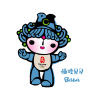 Beibei (贝贝) is a Female and first mascot. She is the Blue Olympic Ring and stands for all the aquatic sports. She represents the Chinese Water element. This Friendly is a Fish, which has the same pronunciation in Chinese as prosperity. But she symbolises a fossil of a fish (old Yangshuo culture seen in the head worn by BeiBei) and therefore wants to show that China has an enormous long history.
Beibei (贝贝) is a Female and first mascot. She is the Blue Olympic Ring and stands for all the aquatic sports. She represents the Chinese Water element. This Friendly is a Fish, which has the same pronunciation in Chinese as prosperity. But she symbolises a fossil of a fish (old Yangshuo culture seen in the head worn by BeiBei) and therefore wants to show that China has an enormous long history. JingJing (晶晶) is a brave male Friendly who stands for the Black Olympic Ring and for the Chinese element of Metal. He is shaped like an Giant panda an animal almost only found in China. Because of his strenght he is the ambassador of strong sports such as Weightlifting and Judo. He represents happiness. The panda is an endangered species and the Chinese government wants to show it's contribution to the preservation of the environment through JingJing.
JingJing (晶晶) is a brave male Friendly who stands for the Black Olympic Ring and for the Chinese element of Metal. He is shaped like an Giant panda an animal almost only found in China. Because of his strenght he is the ambassador of strong sports such as Weightlifting and Judo. He represents happiness. The panda is an endangered species and the Chinese government wants to show it's contribution to the preservation of the environment through JingJing.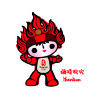 HuanHuan (欢欢) is a male friendly standing for the red Olympic Ring and of course for the Fire element. He is designed to resemble to Olympic Flame. Fire stands for passion and this mascot is extrovert and playful. He supports all ball sports. His meaning to China is of course the fire and passion that spreads to all the Chinese to make the Olympic Games a huge success.
HuanHuan (欢欢) is a male friendly standing for the red Olympic Ring and of course for the Fire element. He is designed to resemble to Olympic Flame. Fire stands for passion and this mascot is extrovert and playful. He supports all ball sports. His meaning to China is of course the fire and passion that spreads to all the Chinese to make the Olympic Games a huge success.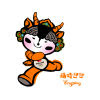 YingYing (迎迎) is a lively female Friendly. The yellow Olympic Ring and the Chinese element of Earth is what she stands for. She is running and symbolises health and she is the mascot for track and field. She is modelled on an Tibetan antelope, which is also an endangered species. Because this animal mainly lives in Tibet she also stand for the diversity of the Chinese population (and also a political statement to say that Tibet is part of China?).
YingYing (迎迎) is a lively female Friendly. The yellow Olympic Ring and the Chinese element of Earth is what she stands for. She is running and symbolises health and she is the mascot for track and field. She is modelled on an Tibetan antelope, which is also an endangered species. Because this animal mainly lives in Tibet she also stand for the diversity of the Chinese population (and also a political statement to say that Tibet is part of China?).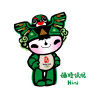 NiNi (妮妮) is the last mascot and also male. The green colour for the green Olympic ring and the element of Wood. Friendly of the gymnastics. She represent an owl. Owl are associated in China with the coming of spring and are an omen of good luck and good fortune. One of the old names of Beijing, Yanjing (also name of a pretty good Chinese beer) is written in Chinese with the character for owl. So NiNi also refers to Beijing, the place of the Olympics
NiNi (妮妮) is the last mascot and also male. The green colour for the green Olympic ring and the element of Wood. Friendly of the gymnastics. She represent an owl. Owl are associated in China with the coming of spring and are an omen of good luck and good fortune. One of the old names of Beijing, Yanjing (also name of a pretty good Chinese beer) is written in Chinese with the character for owl. So NiNi also refers to Beijing, the place of the Olympics
Posted by MiGlainne at 7:31 AM 2 comments
Labels: China, China Olympics
Welcome
Posted by MiGlainne at 2:35 AM 0 comments





